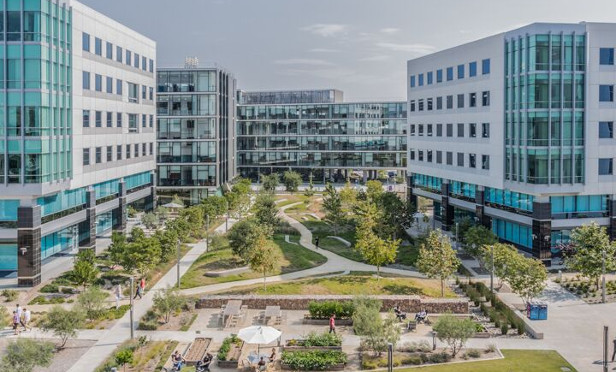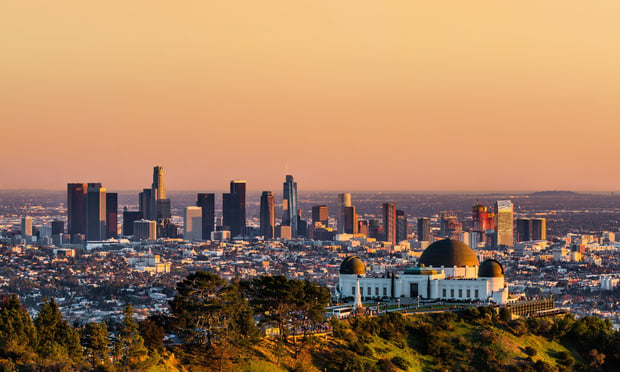
SAN DIEGO—Connectivity to nature is hugely important to employee well-being and can also lead to more synergies among buildings within an office campus, BNIM's principal and director of landscape design Aaron Ross tells GlobeSt.com. Work spaces that inspire employees to run at lunch or talk shop with colleagues as they take a brisk walk are becoming strong recruiting tools—likely now even more so than the ping pong tables and slides of the early 2000s, the firm reports. And according to the US Bureau of Labor Statistics, those living in the Western US region are about 50% more likely to exercise on an average day than are those in the East South Central and West South Central regions of the US, so in the West Coast this is an even more decisive factor of worker happiness than elsewhere.
San Diego's Pacific Center Campus Development, designed by BNIM, melds active campus design ideas and innovative workplace strategies with native plant ecosystems, innovative water strategies and the much-cited productivity benefits of being surrounded by nature. A redevelopment of an existing 20-acre campus for a major Fortune 500 technology company, the PCCD design transforms a generic vehicle-oriented suburban-office development dominated by surface parking and water-dependent lawns into an immersive, pedestrian-oriented campus environment. A result of intense multi-disciplinary collaboration, the project creates a cohesive series of indoor and outdoor spaces that reconnect the users to each other and to the indigenous landscapes of northern San Diego County.
The landscape component of this project was boldly designed to support the company's business goals, improve the health/well-being of employees and office productivity and to significantly enhance the onsite experience (a measured Millennial driver) of employees, both in the workplace and outdoors. The project achieved LEED Gold certification and features impressive design strategies such as diverting and capturing 100% of storm water on-site for treatment and return to the water table.
Ross and Matthew Porreca, principal in charge of BNIM, have worked diligently on this project. We caught up with Ross to discuss PCCD and how landscaping of office projects like it fit in with employee well-being.

GlobeSt.com: How does the landscaping of office projects fit in with employee well-being?
Ross: You can go back 70 or 80 years and find research that has shown that proximity to nature or even the ability to look outside of windows and see a natural scene or vegetation versus hardscape positively impacts people's moods and productivity. It's no different in corporate settings. Office parks all over the place had created very suburban, vehicular-oriented campuses, and a lot of the buildings were surrounded by surface parking, and in some ways a lot of attention hadn't been paid to how the exterior and the interior were interacting.
The idea for PCCD's landscape was really just north of us: Lopez Canyon, a beautiful native canyon typical of the many that run through Northern San Diego, is 300 to 400 yards north of the site and has miles of hiking trails, but you wouldn't know you were near it—you had to leave campus and cross parking lots and a suburban parkway to get to it. Some campus employees would venture up there, but not many. We thought, what if we take that native canyon ecosystem and its trails and drag it from the Lopez Canyon back into the campus? The idea was simple: create space for nature to reinvade the campus setting and then let people go outside and experience it. Design strategies like structured parking allowed us to free up space previously taken up by surface parking in order to achieve this.
The two new buildings that we created at PCCD were designed to have strong relationships between the inside and outside, but our landscape strategy also benefitted the buildings that were already there—buildings that were isolated and disconnected from the surrounding campus and each other. Using the canyon landscape and the strategic placement of the new buildings, we created an immersive experience and brought the new and old campus buildings together. It has become a much more cohesive place that offers many active and passive benefits to the campus users.
GlobeSt.com: Is the trend of using nature to enhance office projects a national one?
Ross: It's national. I live in the Midwest and work on projects all over the place. This is sort of obvious, but the benefit of San Diego and similar climates is that people are more likely to use outdoor space a greater percentage of the year. Spending money on programmable outdoor space is a much easier sell in climates where you can program the space year-round. In these climates, you also have the opportunity to create more exterior building circulation, which helps create better indoor/outdoor relationships—opportunities to blur the lines between inside and outside.
At PCCD, we've been able to create program spaces outside for people to take calls, meet in small groups, work by themselves, etc. This is a national trend, but in the Midwest the emphasis is often more on visual aspects, where you can look out and see nature. It's a little harder to sell the investment in exterior programmable space you can't use for much of the year. In tougher climates, it's the same idea of using nature to enhance and tie together a campus, but primarily in a visual way—the idea of a backdrop versus something you go out and experience.
GlobeSt.com: What is the most special part about the Pacific Center Campus Development?
Ross: This is about transformation. I mentioned earlier that we added two buildings. The campus was composed in a way that was somewhat fragmented and didn't have an identity, no clear way of understanding how the buildings were related to one another. We designed the two new buildings in an integrated way to make them function really well internally, but we also carefully positioned them onsite to make the campus whole. By shaping the campus with the new buildings and the landscape in between, we made all the other buildings on the campus better, too. This speaks to some broader trends.
Years ago, I went to a presentation that discussed how the future of design in the US may be the reinvention and re-envisioning of the suburbs—not designing the perfect project from the ground up, but taking fundamental existing resources and transforming them and making them better. The idea is not to lose the original investment in creating these places by wiping the slate clean, but to decide what works and what doesn't and, in as few moves as possible, totally transform these spaces with strategic additions and subtractions to make them work for the user. Usually these are not complicated strategies, it's just about choosing the right basic strategies that will have the greatest transformational impact. It can be more rewarding if you can find ways to identify the parts of older projects that work really well and weave the new and old together. It's one of the reasons people like cities, for example: layers of design over time ground the spaces in cities and give them both a sense of history and a feeling that they are still alive and changing.
GlobeSt.com: What else should our readers know about this topic?
Ross: Creating a visual backdrop of native landscaping is fine, but what we do is try to make working landscapes that serve ecological purposes and in which people can immerse themselves. This is what the PCCD project is all about. The large wetlands we designed for the campus provide a dramatic backdrop to interior workspaces. But they also can be experienced via outdoor “island” workspaces, and they are doing the heavy lifting of capturing and purifying storm water runoff from the buildings and hardscape. As beautiful as they are, their purpose is very pragmatic and part of a larger ecological and experiential function of the campus.
We also created a big edible garden in the heart of the campus. We partnered with Urban Plantations, an urban-agriculture group out of San Diego, which helped design and subsequently manage the edible gardens. It was important for PCCD and the design team that this wouldn't just be a token demonstration project—the food grown and harvested by Urban Plantations on site goes to the restaurant in the new amenities building onsite, so campus users can eat food they saw being grown on site. Not all the food in the restaurant is coming is from the garden, but we are making a visible connection between where our food comes from and what we're putting into our bodies, and people really enjoy seeing that whole cycle on the site. And these working landscapes can be great for usable outdoor space; one of the most popular hangout spots on campus is amongst the planters in the central edible garden. When we wove the Lopez Canyon landscape through the site and brought the trail with us, we provided a major fitness amenity on the site, and people are using it. The idea is: if I have a workout opportunity that's within mere feet of my workspace and I can see other people using it, I might make it a habit. Design strategies like these work together to create more immersive natural environments that provide health and well-being benefits to the campus users, and they can certainly be replicated on other projects.
Want to continue reading?
Become a Free ALM Digital Reader.
Once you are an ALM Digital Member, you’ll receive:
- Breaking commercial real estate news and analysis, on-site and via our newsletters and custom alerts
- Educational webcasts, white papers, and ebooks from industry thought leaders
- Critical coverage of the property casualty insurance and financial advisory markets on our other ALM sites, PropertyCasualty360 and ThinkAdvisor
Already have an account? Sign In Now
*May exclude premium content© 2025 ALM Global, LLC, All Rights Reserved. Request academic re-use from www.copyright.com. All other uses, submit a request to [email protected]. For more information visit Asset & Logo Licensing.








